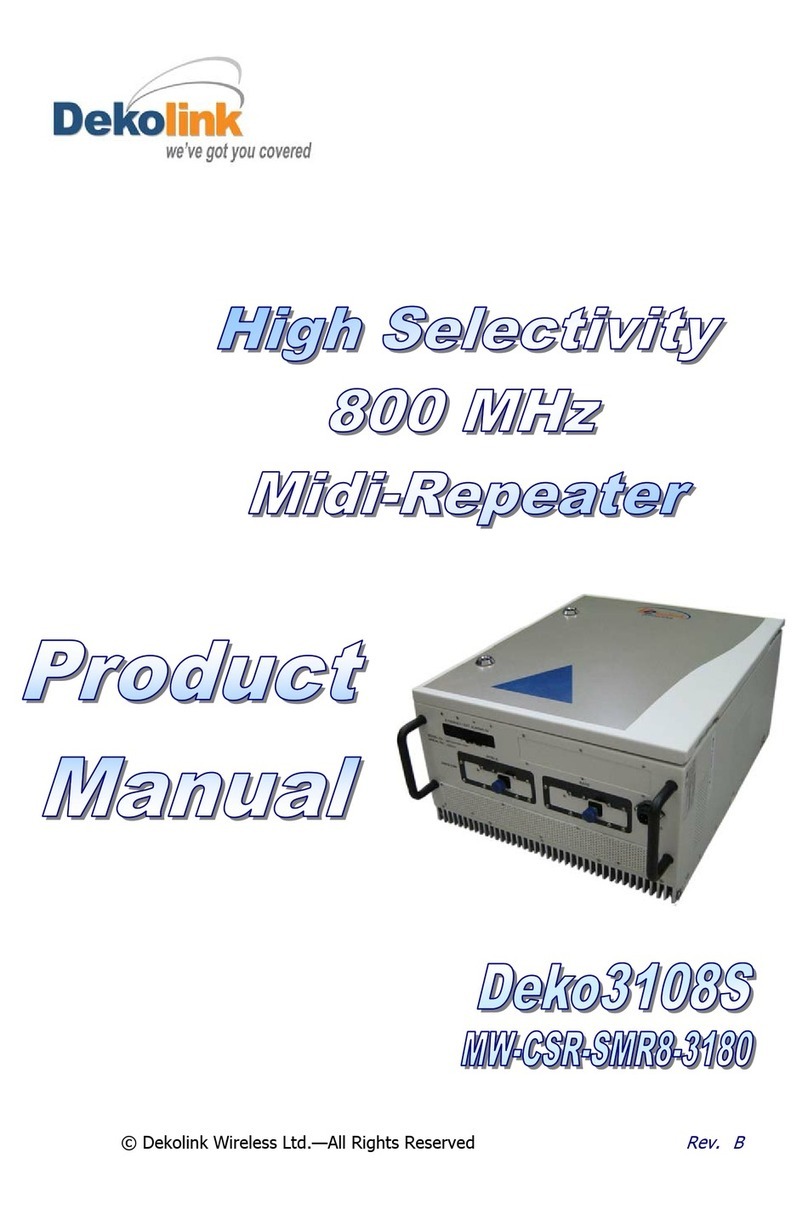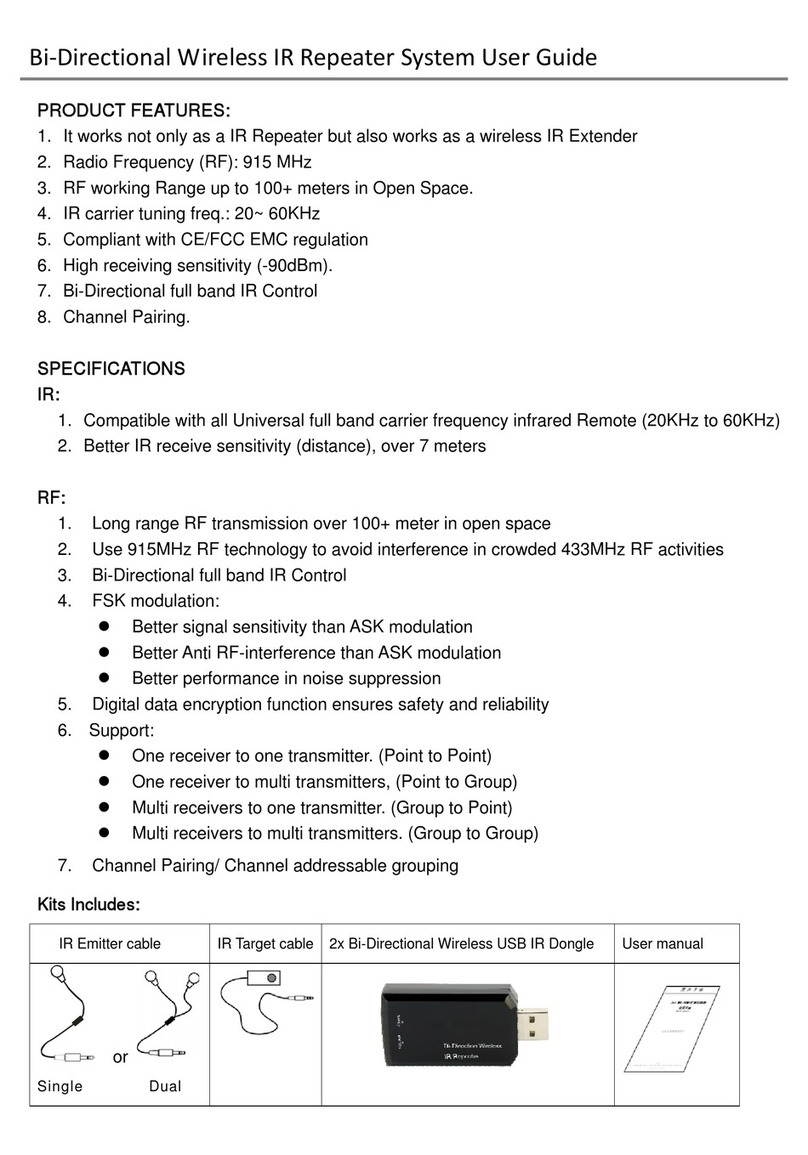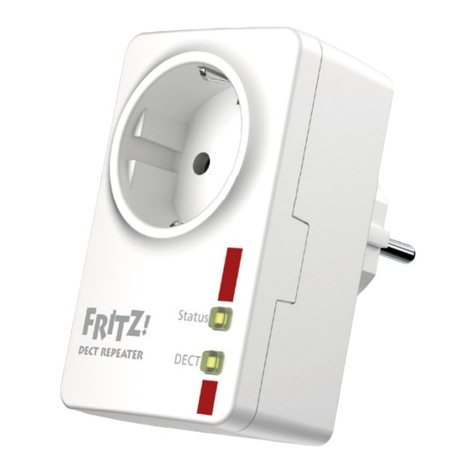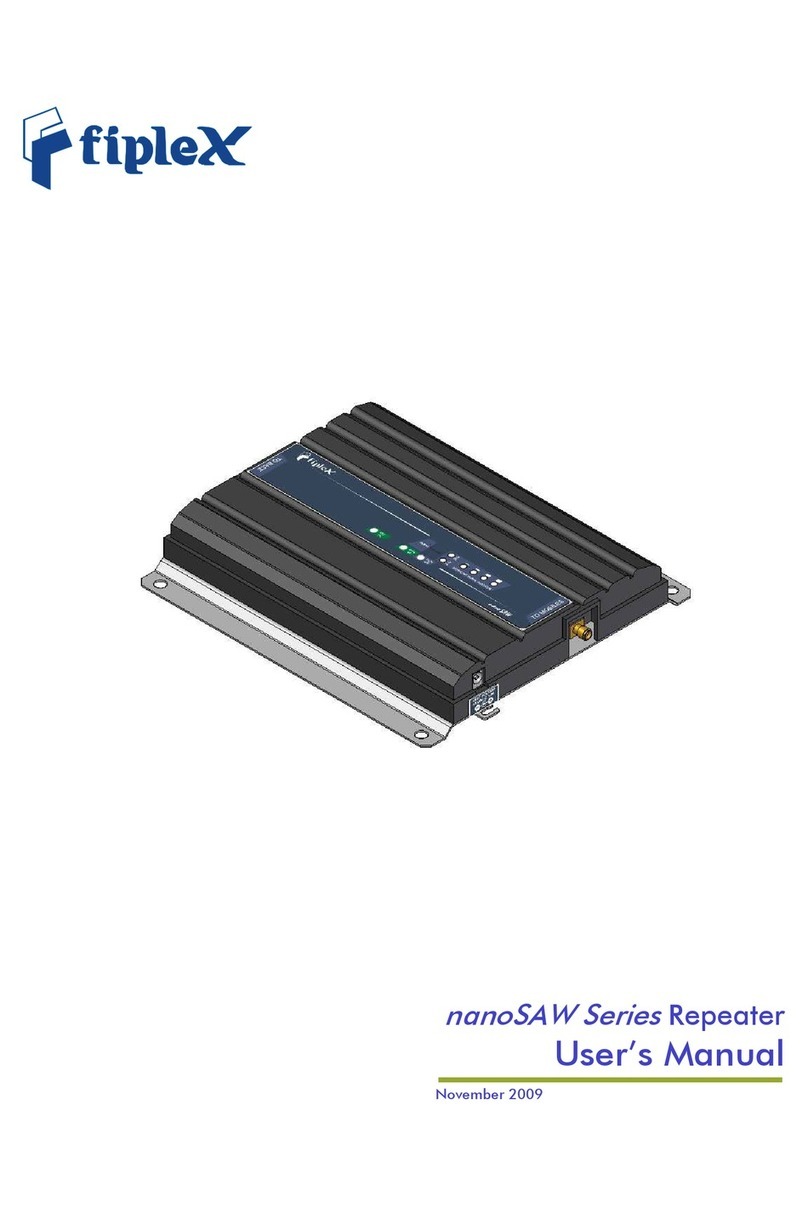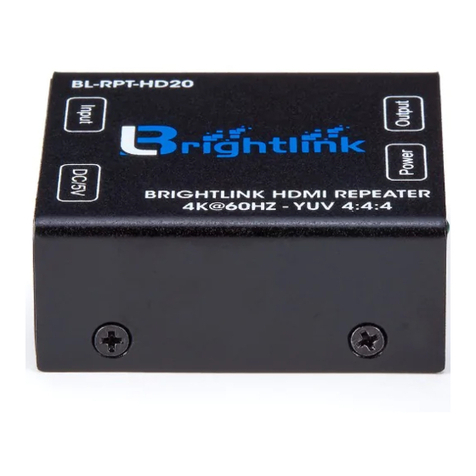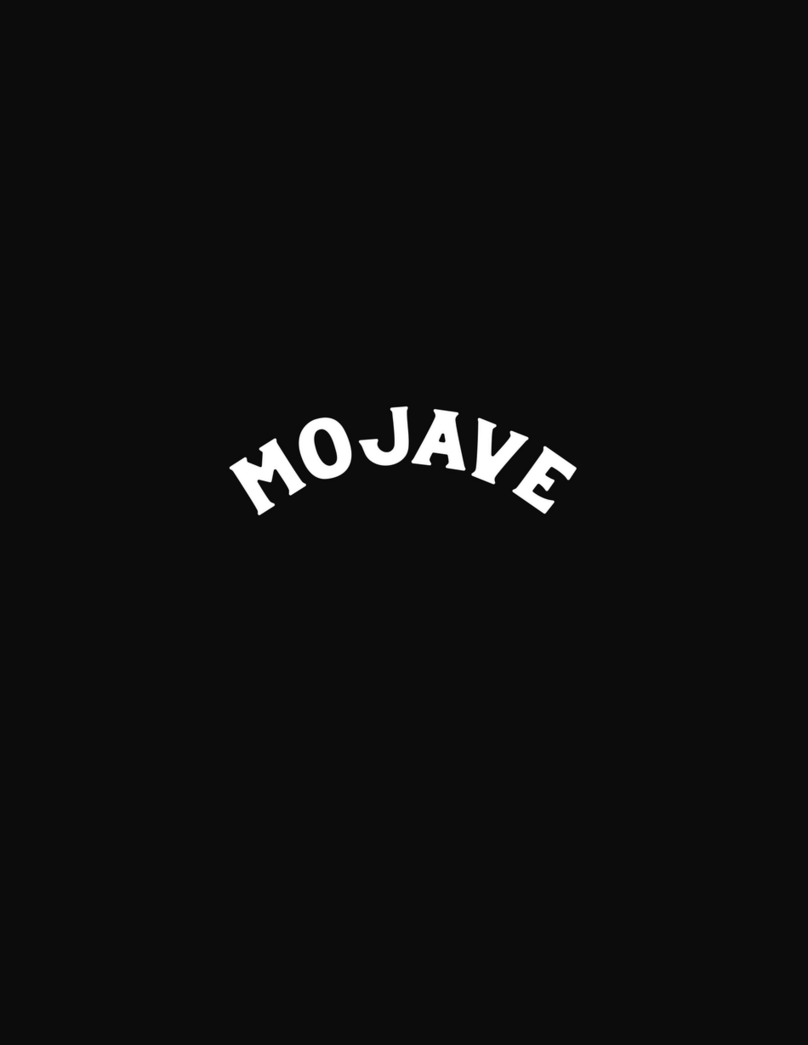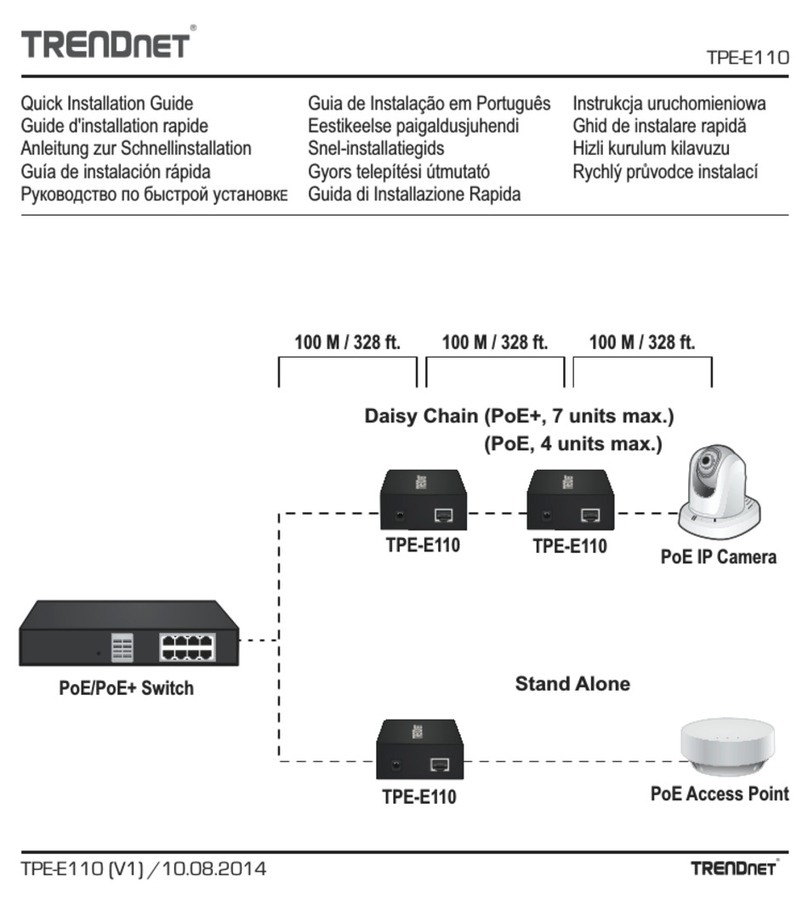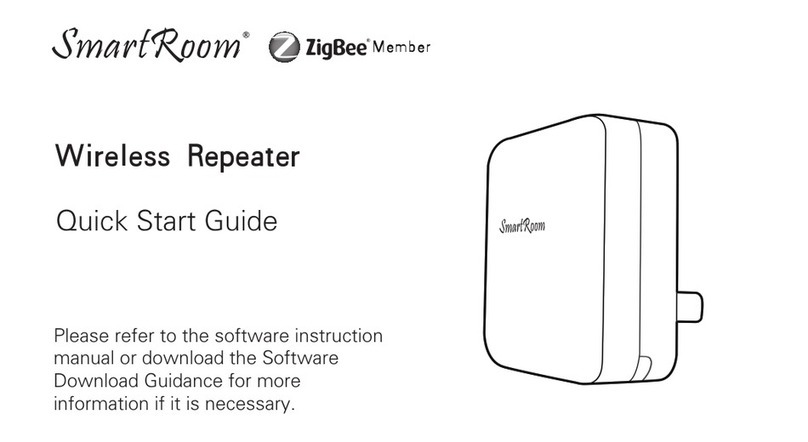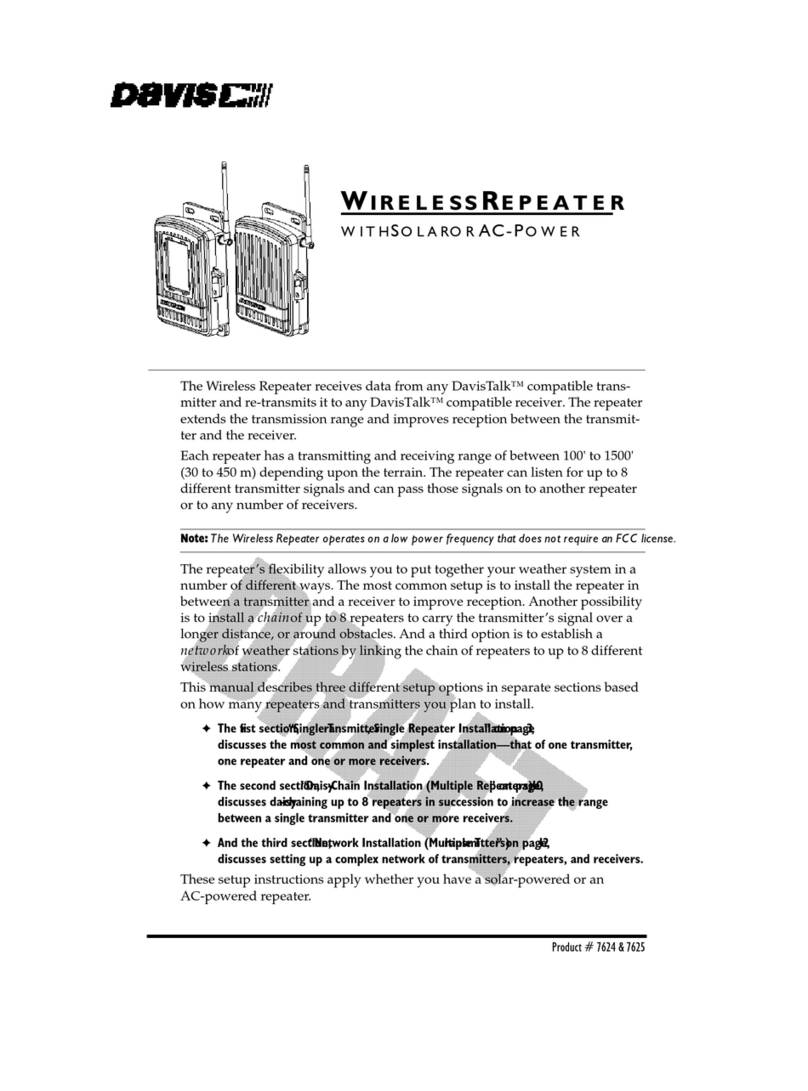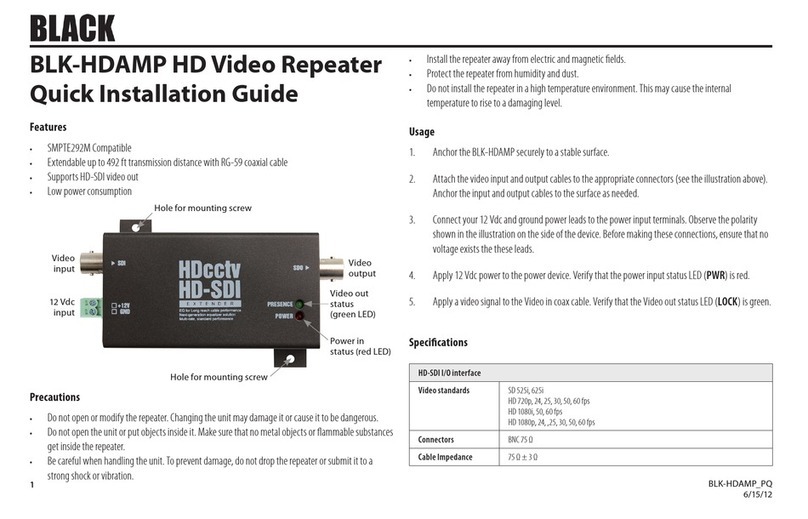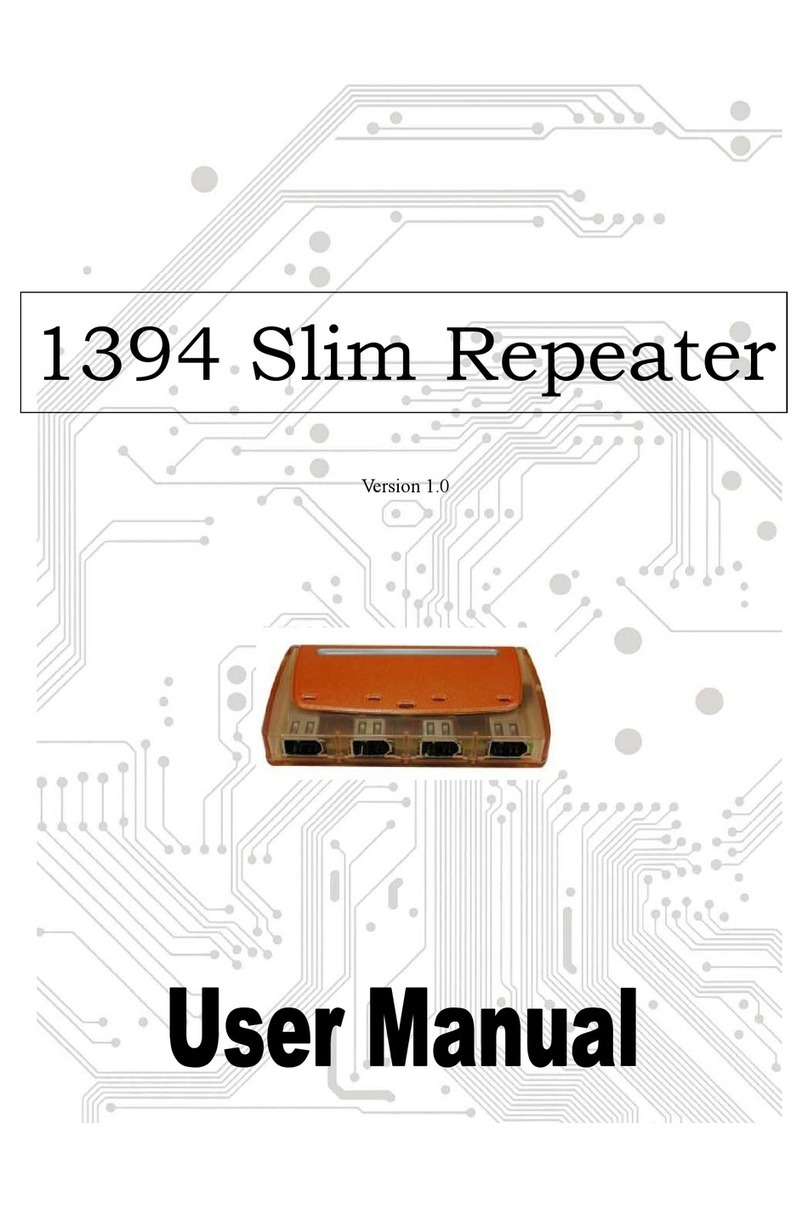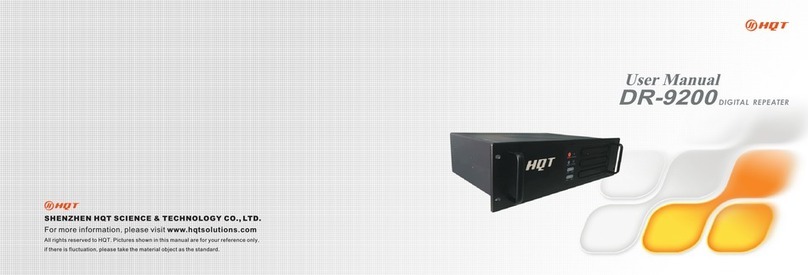NetWorth Micro 100-TX24 User manual

Micro100-TX24
TM
FastEthernetRepeater
User’s Guide
®

Product Information and Customer Support
For product information or technical support, contact NetWorth or your NetWorth Authorized Reseller. You may contact
NetWorth as follows:
tCall NetWorth Technical Support at 214-929-NWTH (6984) Monday through Friday between the hours of 8:00
a.m. and 6:00 p.m., Central Time.
tCall NetWorths BBS at 214-929-4882. The BBS is available 24 hours a day. The modem supports up to 14.4 Kbps
and is configured for no parity, 8 data bits, 1 stop bit, and no flow control.
tAccess NetWorth via CompuServe under Novells Vendor Forum B (Go NVENB).
tContact NetWorth via E-mail at nwsupport@networth.com.
tContact NetWorth via its World Wide Web site at http://www.networth.com.
tWrite NetWorth at:
NetWorth, Inc.
8404 Esters Blvd.
Irving, Texas 75063
Attn: Technical Support
Copyright
This manual and any software described in it are copyrighted, with all rights reserved. Under the copyright laws, neither
this manual nor the software may be copied, in whole or in part, without written consent of NetWorth, Inc., except as
provided in the enclosed NetWorth, Inc. Software License. Under the law, copying includes translating into another
language or format.
The software contains proprietary, confidential and unpublished information of NetWorth, Inc. No use or disclosure of
any portion of this material may be made without the prior express written consent of NetWorth, Inc.
Special Note for Government End Users
This manual and any software described in it are provided with Restricted Rights. Please refer to the NetWorth, Inc.
Software License enclosed with the product for a complete description of the rights granted.
NetWorth, Inc.
8404 Esters Blvd.
Irving, Texas 75063
© NetWorth, Inc. 1995. All rights reserved.
Printed in the United States of America.
Hardware Warranty
Please refer to the warranty information enclosed with the product.
Micro 100-TX24 Repeater User’s Guide
ii

Software License
Please refer to the NetWorth, Inc. Software License enclosed with the product.
Disclaimer
NetWorth provides software and the related documentation on an AS IS basis, without warranty. NetWorth software
is not designed or licensed for use in in-line control of equipment in hazardous environments such as operation of
nuclear facilities, aircraft navigation or control, or direct life support machines. Please refer to the NetWorth, Inc.
Software License enclosed with the product for a complete statement of NetWorth, Inc.s obligations regarding any
software licensed hereunder.
This manual is provided on an AS IS basis. NetWorth, Inc. makes no representations or warranties with respect to
the contents or use of this manual, and EXPRESSLY DISCLAIMS ALL WARRANTIES, EXPRESS OR IMPLIED,
INCLUDING, BUT NOT LIMITED TO, THE IMPLIED WARRANTIES OF MERCHANTABILITY AND FITNESS
FOR A PARTICULAR PURPOSE. Further, NetWorth, Inc. reserves the right to revise this publication and to make
changes to its content, at any time, without obligation to notify any person or entity of such revisions or changes.
Trademarks
NetWorth is a registered trademark and the NetWorth logo, the stylized Net, and Micro 100-TX24 are trademarks of
NetWorth, Inc. Teflon is a registered trademark of E.I. Du Pont de Nemours and Company. All other trademarks are the
property of their respective owners.
FCC Radio Frequency Interference Regulatory Statement
Note: This equipment has been tested and found to comply with the limits for a Class A digital device, pursuant to Part
15 of the FCC Rules. These limits are designed to provide reasonable protection against harmful interference when the
equipment is operated in a commercial environment. This equipment generates, uses and can radiate radio frequency
energy and, if not installed and used in accordance with the instructions in this manual, may cause interference to radio
communications. Operation of this equipment in a residential area is likely to cause harmful interference in which case
the user will be required to correct the interference at his own expense.
Canadian Department of Communications
Radio Frequency Statement
This digital apparatus does not exceed the Class A limits for radio noise emissions from digital apparatus set out in the
Radio Interference Regulations of the Canadian Department of Communications.
Le présent appareil numérique német pas de bruits radioélectriques dépassant les limites applicables aux appareils
numériques de la classe A prescrites dans le Règlement sur le brouillage radioélectrique édicté par le ministères des
Communications du Canada.
Note: This equipment has not been tested by the Canadian Department of Communications. However, the CDC accepts
FCC test data.
Micro 100-TX24 Repeater User’s Guide
iii

Electromagnetic Interference Performance Compliance
The Micro 100-TX24 repeater meets or exceeds the following EMI requirements:
tFCC Class A
tCISPR 22 (EN55022) Class A
Safety Compliance
The Micro 100-TX24 repeater complies with the following safety standards:
tUL 1950 Second Edition, 1989; Second Edition, 1991 Safety of Information Technology Equipment
tCSA Standard CAN/CSA-C22.2 No. 950-M-93 (Canadian Standards Association for Information Technology
Equipment)
tTUV Rheinland EN60950/1988 + A1/1990 + A2/1991
European Community Immunity Test Standards
The Micro 100-TX24 repeater complies with the following emissions standards:
tIEC 801-2 (Electrostatic Discharge)
tIEC 801-3 (Radiated Immunity)
tIEC 801-4 (Electrical Fast Transient/Burst)
tEN55101-4 (Conducted Immunity)
Micro 100-TX24 Repeater User’s Guide
iv

Contents
About This Manual
Intended Reader....................................................................................................................................vii
Organization of Contents.......................................................................................................................vii
Chapter 1 — Overview
Features...............................................................................................................................................1-1
Package Contents ...............................................................................................................................1-2
Operational Overview ..........................................................................................................................1-3
LED Indicators...............................................................................................................................1-4
RJ-45 Ports ...................................................................................................................................1-5
Uplink Switch.................................................................................................................................1-5
Chapter 2 — Planning Repeater Installation
Installation Requirements ....................................................................................................................2-1
Environmental Requirements........................................................................................................2-1
Electrical Requirements ................................................................................................................2-1
Spatial Requirements....................................................................................................................2-2
Twisted-Pair (UTP) Wire Requirements........................................................................................2-2
Installing New Wire.................................................................................................................2-2
System Planning Charts......................................................................................................................2-4
Micro 100-TX24
Repeater Setup and Cabling Chart.....................................................................2-4
Rack Inventory Chart.....................................................................................................................2-5
Chapter 3 — Installing the Repeater
Mounting the Repeater........................................................................................................................3-1
Attaching the Rubber Feet ............................................................................................................3-1
Rack-Mounting the Repeater ........................................................................................................3-2
Connecting Twisted-Pair Cable............................................................................................................3-3
Setting the Uplink Switch.....................................................................................................................3-3
Interconnecting Repeaters...................................................................................................................3-4
Connecting Power ...............................................................................................................................3-5
Disconnecting Power.....................................................................................................................3-5
Replacing the Power Supply.........................................................................................................3-5
Installing a Redundant Power Supply Module.....................................................................................3-6
Appendix A — Specifications
Glossary
Index
v

AboutThisManual
This manual includes information about how to install and operate the Micro 100-TX24 Fast Ethernet Repeater. We
recommend that you read all chapters in this manual to become familiar with all of the repeaters features and to
ensure a successful installation.
Intended Reader
This manual is written for network administrators and technicians responsible for hardware installation.
Organization of Contents
The contents of this manual are organized as follows:
Chapter 1 Overview provides an operational overview of the Micro 100-TX24 repeater and describes its
components and features.
Chapter 2 Planning Repeater Installation discusses special requirements for operating the repeater and provides
charts that can help you plan the installation of the repeater.
Chapter 3 Installing the Repeater provides instructions for mounting the repeater, connecting cable,
interconnecting the repeater to another repeater, and connecting power to the repeater. Also included are instructions
for installing a redundant power supply module.
Appendix A Specifications includes the repeaters electrical, physical, and environmental specifications.
The Glossary provides terms related to the Micro 100-TX24 repeater, as well as general networking terms.
vii

Chapter1 Introduction
The Micro 100-TX24 Fast Ethernet Repeater provides 100BASE-TX functionality for 24 RJ-45 ports. The repeaters
uplink capability lets you connect the repeater to another Micro 100-TX24 repeater or other 100BASE-TX repeater.
For backup power, you can install an optional redundant power supply. The Micro 100-TX24 repeaters front panel
makes it easy to view the current operating status.
Features
The Micro 100-TX24 repeater includes these features:
t24 shielded RJ-45 ports that support 100BASE-TX connections
tUplink port that enables bridging to 100BASE-TX topologies
tLEDs that indicate power supply status (A and B), collisions, and port link/activity/partition status
tModular power supply design for easy removal and replacement
tAuto-sensing power supply operates within the range of a 100-240 VAC, 50-60 Hz power source
tOptional dual-redundant power supply
tClass II support for 100BASE-TX
tCompatibility with the IEEE 802.3u 100BASE-TX repeater specification
tChassis that can stand alone or be mounted in a standard, EIA 19-inch rack
tSurface-mount technology
tConforms to FCC, CISPR, UL, TUV, CSA, and CE test standards
1 - 1

Package Contents
Before you start to install the Micro 100-TX24 repeater, verify that this package contains the following items:
tMicro 100-TX24 Fast Ethernet repeater
tAC power cord
tRack-mount kit (two mounting brackets, eight 3/8-inch bracket screws, and four 1/2-inch rack-mount screws)
tFour adhesive-backed rubber feet
tMicro 100-TX24 Fast Ethernet Repeater Users Guide
tRegistration card
tWarranty card
NetWorth, Inc.
Limited Warranty
Rack-Mounting Brackets
Micro 100-TX24
Fast Ethernet Repeater
User’s Guide
User’s Guide
Product Registration
Card
Power Cord
Micro 100-TX24
Repeater
1/2-inch Rack Mount Screws (4)
3/8-inch Bracket Screws (8)
Rubber Feet (4)
NetWorth, Inc.
Limited Warranty
MDI-X
MDI-X
1
13
2
14
3
15
4
16
5
17
6
18
7
19
8
20
9
21
10
22
11
23
12
24
COL
PWR A
PWR B
MDI MDI-X
®
Micro 100-TX24™
Fast Ethernet Repeater
Figure 1-1: Micro 100-TX24 Package Contents
Package Contents Introduction
1 - 2

Operational Overview
This section provides an overview of the Micro 100-TX24 repeaters components, which include the LED indicators,
RJ-45 ports, and uplink ports, and discusses the basic functionality of the repeater. Figures 1-2 and 1-3 show the
repeaters front and back panel.
MDI-X
MDI-X
1
13
2
14
3
15
4
16
5
17
6
18
7
19
8
20
9
21
10
22
11
23
12
24
COL
PWR A
PWR B
MDI MDI-X
®
Power Supply and
100BASE-T Collision
Status Indicators
Uplink Switch
(24) RJ-45 UTP Ports
(for 100BASE-TX)
Micro 100-TX24™
Fast Ethernet Repeater
Figure 1-2: Micro 100-TX24 Repeater Front Panel
PWR B PWR A
Optional Power Supply B
(Backup) Power Supply A
(Pre-installed)
Figure 1-3: Micro 100-TX24 Repeater Back Panel
Introduction Operational Overview
1 - 3

LED Indicators
The Micro 100-TX24 repeater features several LED indicators that help you monitor the repeaters status.
tThe LEDs on the left side of the front panel show the status of the power supplies as well as the 100BASE-TX
collision status.
tThe LEDs above the RJ-45 ports indicate the link, activity, and partition status for each of the ports.
Figure 1-4 shows the LED arrangement for the Micro 100-TX24 repeater.
The following chart shows the possible conditions of each LED and describes the meaning of each condition.
LED Condition Meaning
PWR A and PWR B Steady Green
Off
Steady yellow
The power supply is currently functioning and providing power to the
hub.
No power is supplied to the hub by the specified power supply.
The power supply is installed but not powered on or is defective.
COL Flashing yellow
Off
The hub detects a collision.
No collisions are occurring.
RJ-45 Steady green
Steady yellow
Flashing green
Off
Alink condition is present.
The port is disabled (autopartitioned).
There is activity at the port.
No link condition is present at the port or there is no connection at the
port.
Note: LEDs listed as “yellow” might appear orange on the hub’s front panel.
MDI-X
MDI-X
1
13
2
14
3
15
4
16
5
17
6
18
7
19
8
20
9
21
10
22
11
23
12
24
COL
PWR A
PWR B
MDI MDI-X
®
Power Supply and
100BASE-TX Collision
Status Indicators
RJ-45 Link/Partition/Activity
LED Indicators
Micro 100-TX24
™
Fast Ethernet Repeater
Figure 1-4: LED Indicators
Operational Overview Introduction
1 - 4

RJ-45 Ports
The Micro 100-TX24 repeater has 24 RJ-45 ports that let you connect UTP cabling to workstations and servers in a
100BASE-TX network.
Uplink Switch
The uplink switch lets you convert the 12th port on the Micro 100-TX24 repeater to an uplinkable OUT RJ-45 port.
This lets you interconnect the Micro 100-TX24 repeater to another Micro 100-TX24 repeater or other 100BASE-TX
repeater, allowing the two repeaters to be on the same segment.
IN ports use an internal crossover of the receive and transmit lines, enabling the port to connect to a network interface
card using standard 8-wire UTP cable. OUT ports use a straight-through (uncrossed) connection.
MDI
MDI-X
MDI-X
1
13
2
14
3
15
4
16
5
17
6
18
7
19
8
20
9
21
10
22
11
23
12
24
COL
PWR A
PWR B
MDI-X
®
(24) RJ-45 UTP Ports
(for 100BASE-TX)
Micro 100-TX24™
Fast Ethernet Repeater
Figure 1-5: RJ-45 Ports
MDI-X
MDI-X
1
13
2
14
3
15
4
16
5
17
6
18
7
19
8
20
9
21
10
22
11
23
12
24
COL
PWR A
PWR B
MDI MDI-X
®
MDI MDI-X Standard
"IN" Repeater Port
(Default)
Uplinkable
"OUT" Port
Micro 100-TX24™
Fast Ethernet Repeater
Figure 1-6: Uplink Switches
Introduction Operational Overview
1 - 5

Chapter2 PlanningRepeaterInstallation
This chapter contains information that will help you prepare for installing the Micro 100-TX24 repeater. This includes
installation requirements and system planning charts.
Installation Requirements
To help ensure a correct installation, read this section to determine the environmental, electrical, spatial, and cable
requirements.
Environmental Requirements
Be sure the operating environment for the repeater is within the following ranges:
tTemperature: 32º to 122ºF (0º to 50ºC)
tHumidity: 5% to 95% (non-condensing)
tAltitude: 0 to 10,000 feet (0 to 3 km)
tClearance: minimum of 2 inches (5.1 centimeters) on each side of the repeater for proper ventilation
Electrical Requirements
The electrical requirements for a Micro 100-TX24 repeater are as follows:
t100 240 VAC
t1.5 0.75 Amps (1.5A @ 100 VAC 0.75A @ 240 VAC)
t50 60 Hz
Caution: The power outlet must be a non-switched, three-pronged, grounded outlet. Do not use a
three-to-two pronged adapter at the outlet. Doing so may result in electrical shock and/or damage to
the repeater and will void your warranty.
Note: Ifthe suppliedpower cord is lost or damaged, replace it with a power cord of the same type and
current rating (10A). The replacement cord should also meet required regulatory approvals to ensure
emissions compliance.
2 - 1

Spatial Requirements
The Micro 100-TX24 repeaters dimensions are 3 inches (height) x 16.95 inches (width) x 14 inches (depth).
You can interconnect two Micro 100-TX24 repeaters. If there is not enough space to mount the repeaters in a single rack
or stack them on a single shelf, or if you want to place the repeaters in different locations, you can place them side by
side on separate shelves or in separate racks. See Twisted-Pair (UTP) Wire Requirements for more information.
Be sure to allow at least 2 inches (5.1 centimeters) on each side of the repeater for proper air circulation and cable
connections.
Twisted-Pair (UTP) Wire Requirements
The twisted-pair wiring you use to connect the repeaters RJ-45 ports must meet the following minimum specifications
and requirements to ensure long-term reliability.
tThe wiring must be unshielded twisted-pair (UTP) Category 5.
tTwo pairs of the four-pair wiring are used for signalling.
tDepending on building codes, different insulation materials may be required. Plenum-rated or TEFLON®-coated
wiring may be required in some areas.
tThe wire gauge should be between 18 and 26 AWG. (Most telephone installations use 24-gauge wiring.)
tSolid copper
Installing New Wire
If you are installing the repeater where no wiring is present, or if existing wiring does not meet the above
specifications, install new wiring. The new wiring should conform to national and local electrical wiring code
requirements and meet the above specifications. When installing wire, it is a good idea to install extra pairs of wire
for future expansion.
If you are unfamiliar with wiring installation or the applicable local electrical wiring code or the 100BASE-TX
specification, you should have a professional, licensed (if applicable) installer perform the installation.
Installation Requirements Planning Repeater Installation
2 - 2

Straight-through twisted-pair cable is typically used to connect a repeater to a server or workstation. In a
straight-through connection, Pin 1 at the repeater connects to Pin 1 at the server, Pin 2 at the repeater connects to Pin 2
at the server, and so on. Figure 2-1 shows the locations of pins on a standard RJ-45 plug on a twisted-pair cable.
Tables 2-1 and 2-2 show the wiring in a straight-through and crossover twisted-pair cable.
Twisted Pair
No. Pin No. Signal
Description at DTE To Pin No. Signal
Description at
Repeater
11
2TD+
TD– à1
2RD+
RD–
23
6RD+
RD– à3
6TD+
TD–
Twisted Pair
No. Pin No. Signal
Description at DTE To Pin No. Signal
Description at
Repeater
11
2RD+
RD– à3
6TD+
TD–
23
6TD+
TD– à1
2RD+
RD–
Twisted-Pair Cable
RJ-45 Plug
1236
Pins
Figure 2-1: RJ-45 Plug Pin Locations
Table 2-1: Wiring in a Straight-Through Twisted-Pair Cable
Table 2-2: Wiring in a Crossover Twisted-Pair Cable
Planning Repeater Installation Installation Requirements
2 - 3

System Planning Charts
The charts in Figures 2-2 and 2-3 provide a convenient way of planning the connections for your Micro 100-TX24
repeater.
Port Connects To
8
17
7
16
22
23
24
6
15
21
5
11
12
13
14
20
4
3
10
19
2
9
18
1
Micro 100-TX24
Repeater Setup and Cabling Chart
Unit Number
Building
Location
Rack Mount
Table
Uplink Switch Setting
MDI-X (default)
MDI (uplinkable)
Date
Figure 2-2: Micro 100-TX24 Repeater Setup and Cabling Chart
System Planning Charts Planning Repeater Installation
2 - 4

Rack Inventory Chart
Use this chart to record the components installed in a particular rack.
Wiring Closet Number
Rack Number
Installer
Date
Example
Micro 100-TX24
Micro 100-TX24
Figure 2-3: Rack Inventory Chart
Planning Repeater Installation System Planning Charts
2 - 5

Chapter3 Installingthe Repeater
This chapter explains how to mount the Micro 100-TX24 repeater, attach cables, and interconnect the repeater to a
second repeater.
Mounting the Repeater
You can place the Micro 100-TX24 repeater on a level surface (table top or shelf, for example) or mount it in a standard
EIA 19-inch rack.
Attaching the Rubber Feet
If you will place the repeater on a table top or shelf, attach the supplied adhesive-backed rubber feet as described in the
following steps.
1. Turn the repeater over so that its bottom side faces up.
2. Remove the four rubber feet from their packaging.
3. Peel the protective paper backing off the rubber feet. Then position the feet in the recessed areas near the corners
of the repeater and press the feet into place.
4. Turn the repeater to its upright position and place it on the mounting surface.
Note: Be sure you allow at least 2 inches on each side of the repeater for proper air flow.
3 - 1

Rack-Mounting the Repeater
The Micro 100-TX24 occupies two slots in a standard, 19-inch rack. To mount the Micro 100-TX24 repeater in a rack,
use the supplied installation kit. This kit includes two side mounting brackets, eight bracket screws, and four larger
rack-mount screws.
To attach the brackets, follow these steps:
1. Remove the two screws from the left and right side of the repeater. (These screws are extras and are not needed to
install the mounting brackets.)
2. Position the bracket as shown in Figure 3-1, and secure it with the smaller bracket screws. Then attach the
remaining bracket to the other side of the repeater.
After you attach both mounting brackets, position the bracket slots over the desired holes on the rack (Figure 3-2). Then
insert and tighten the supplied rack-mount screws.
9
21
10
22
11
23
12
24
MDI MDI-X
Bracket Screws
Micro 100-TX24
™
Fast Ethernet Repeater
Figure 3-1: Attaching the Mounting Brackets
MDI-X
MDI-X
1
13
2
14
3
15
4
16
5
17
6
18
7
19
8
20
9
21
10
22
11
23
12
24
COL
PWR A
PWR B
MDI MDI-X
®
Rack-mount Screws
Micro 100-TX24
™
Fast Ethernet Repeater
Figure 3-2: Positioning the Repeater in a Rack
Mounting the Repeater Installing the Repeater
3 - 2

Connecting Twisted-Pair Cable
Each RJ-45 port on the Micro 100-TX24 repeater can accept a standard 8-wire twisted-pair (UTP) cable that ends with
an RJ-45 connector. These ports can support cable lengths up to 100 meters.
To attach twisted-pair cable, plug one of the RJ-45 connectors into the selected port on the repeater. Connect the other
RJ-45 connector into a 100BASE-TX workstation.
Setting the Uplink Switch
The uplink switch enables the 12th port on the Micro 100-TX24 repeater to function as either standard IN RJ-45 ports
or uplinkable OUT RJ-45 ports.
IN ports use an internal crossover of the receive and transmit lines, enabling the port to connect to a network interface
card using standard 8-wire UTP cable. OUT ports use a straight-through (uncrossed) connection, which lets you
interconnect the Micro 100-TX24 repeater and another repeater without the need for special crossover cables and allows
the two repeaters to be on the same segment.
The default setting for the uplink switch is MDI-X(Media Dependent Interface-Reversed i.e., standard repeater port).
To convert Port 12 to an uplinkable port, use a small, slotted screwdriver, or a similar tool, to set the switch to the MDI
position.
100BASE-TX Workstation
MDI-X
MDI-X
1
13
2
14
3
15
4
16
5
17
6
18
7
19
8
20
9
21
10
22
11
23
12
24
COL
PWR A
PWR B
MDI MDI-X
®
Micro 100-TX24
™
Fast Ethernet Repeater
Figure 3-3: Connecting Twisted-Pair Cable
Installing the Repeater Connecting Twisted-Pair Cable
3 - 3

Interconnecting Repeaters
You can interconnect two Micro 100-TX24 repeaters, providing up to 48 ports in the same collision domain (segment).
You can also connect the Micro 100-TX24 repeater to another 100BASE-TX repeater.
To connect the Micro 100-TX24 repeater to another repeater, set the appropriate uplink switch as described under
Setting the Uplink Switch and connect the repeaters as shown in Figure 3-5.
Note: The maximum distance between repeaters is 5 meters. The maximum distance from the
repeater to a DTE is 100 meters. The total maximum end-to-end length of the collision domain is 205
meters.
MDI-X
MDI-X
1
13
2
14
3
15
4
16
5
17
6
18
7
19
8
20
9
21
10
22
11
23
12
24
COL
PWR A
PWR B
MDI MDI-X
®
MDI MDI-X
Standard
"IN" Repeater Port
(Default)
Uplinkable
"OUT" Port
Micro 100-TX24
™
Fast Ethernet Repeater
Figure 3-4: Uplink Switch
MDI-X
MDI-X
MDI-X
MDI-X
1
1
13
13
2
2
14
14
3
3
15
15
4
4
16
16
5
5
17
17
6
6
18
18
7
7
19
19
8
8
20
20
9
9
21
21
10
10
22
22
11
11
23
23
12
12
24
24
COL
COL
PWR A
PWR A
PWR B
PWR B
MDI
MDI
MDI-X
MDI-X
®
®
MDI MDI-X
Micro 100-TX24
™
Fast Ethernet Repeater
Micro 100-TX24
™
Fast Ethernet Repeater
Figure 3-5: Interconnecting Micro 100-TX24 Repeaters
Interconnecting Repeaters Installing the Repeater
3 - 4
Table of contents
